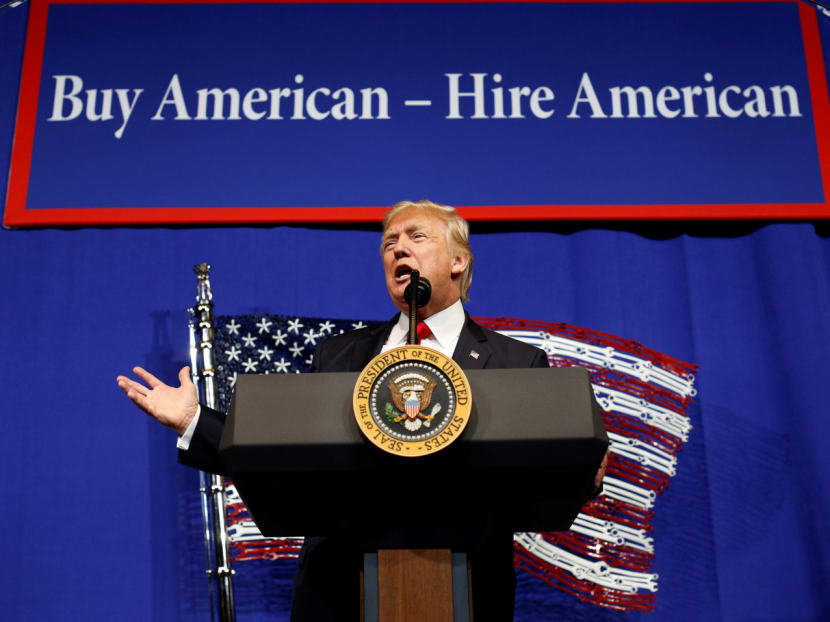US protectionism: Trade tariffs will hurt it the most
With its America First policy, the Trump administration has indicated that it wants to relook trade agreements with countries where the United States buys more than it sells, including China, Japan, South Korea and Germany.

United States President Donald Trump has vigorously championed protectionism as a way of saving the country’s manufacturing jobs and reducing income inequality. Photo: Reuters
With its America First policy, the Trump administration has indicated that it wants to relook trade agreements with countries where the United States buys more than it sells, including China, Japan, South Korea and Germany.
However, in an era of global supply chains, such a focus on bilateral trade deficits is meaningless.
The US is deeply embedded into global supply chains, although it is not a big export hub. Its integration into supply chains is more a reflection of its role as global importer-in-chief and it imports a significant amount of goods with value-added content originating in the US.
The US is actually one of the three largest suppliers in value-added terms to the exports of China, Japan, Mexico and Germany, so US tariffs and barriers imposed on these countries would only come back to hurt US companies.
There is also little evidence that tariffs and barriers on particular countries would lead to higher production in the US and lower imports. More likely, the gap would just be filled by imports from countries that produce similar goods.
President Trump has vigorously championed protectionism as a way of saving US manufacturing jobs and reducing income inequality. However, previous episodes of US protectionism have only caused net job losses in the economy.
For example, in 2002 the US imposed tariffs on the imports of certain types of steel for a period of three years. This was supposed to protect jobs in the US steel industry, which employed 185,000 people in December 2002. However, jobs were lost in industries that used steel as an input in their production as a result of the tariffs.
According to an impact analysis conducted by the Consuming Industries Trade Action Coalition Foundation, around 200,000 jobs were lost in industries such as fabricated metal products and household appliances, as well as in chemicals and petroleum refining.
One in five jobs in the US is linked to its imports and exports, so a tit-for-tat trade war with America’s main trading partners threatens to weaken the US job market rather than bolster it.
More protectionism could also worsen inequality within the US: Typically, the poorest are hit hardest, as prices go up and the choice of goods is reduced.
Tariffs are particularly damaging to lower-income households, which tend to spend proportionately more on traded goods such as food and clothes.
According to a study done last year by David G Tuerck and his colleagues at the Beacon Hill Institute at Suffolk University, Mr Trump’s proposals of a 45 per cent tax on China and Japan and 35 per cent on Mexico would, over a five-year period, reduce the mean after-tax income of the lowest 10 per cent of US households by 18 per cent, compared with by just 3 per cent for the highest 10 per cent of US households.
President Donald Trump wants to lower the US trade deficit, but his plans to boost fiscal spending to reinvigorate the domestic economy run counter to this ambition.
A country’s trade deficit shows that it is investing more than it saves. Thus, the US trade deficit should be reduced by raising savings in comparison with investment, but the US administration is planning to do the exact opposite.
Cutting taxes and raising infrastructure spending is likely to result in higher domestic prices and greater import demand, leading to a wider trade deficit, which might in turn prompt even greater protectionism from the US authorities.
With supply chains being increasingly global, headwinds will be felt far beyond the countries targeted with tariffs.
In relation to their GDPs, places such as Singapore and Hong Kong are the most dependent on global supply chains, reflecting their role as business service centres. The value of their participation in global supply chains is more than 80 per cent of their respective GDPs. Some other Asian economies, such as South Korea, Malaysia and Taiwan, are also tightly integrated into the supply chains of China and they, too, would be hurt by any trade spat.
By contrast, some countries stand to gain from creeping US protectionism, as they will have the opportunity to grab a greater share of world trade. The main competitors for US trade are China, Mexico, Germany and Japan, which fiercely compete with each other, so measures against one would benefit the others. Other countries could win as well: Vietnam, Thailand and the Philippines in Asia, the United Kingdom in Europe.
Ultimately, however, US protectionism poses a threat, not just to the US economy, but also to world trade and prosperity.
Global import demand could weaken in the near term as few countries can match US demand. But can any country replace the US as the global importer-in-chief over the more medium term?
European countries face high debt levels and demographic challenges that suggest weaker growth and demand, especially for manufacturing products. Asian economies, particularly China, are better suited to replace the US as the largest global importer in the medium term.
China has already begun to assume a greater role in global trade, championing trade deals such as the Regional Comprehensive Economic Partnership and using initiatives such as One Belt One Road to expand its involvement in global trade and investment flows.
While the US and Europe remain the largest consumers of Asian supply-chain products, China is slowly rising in importance as a final demand destination.
Greater US protectionism is only going to hasten China’s rise as a true mega-trader of the world, a position last held by colonial Britain.
ABOUT THE AUTHOR:
Madhur Jha is Head of Thematic Research at Standard Chartered.






